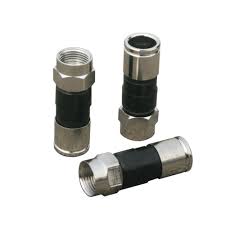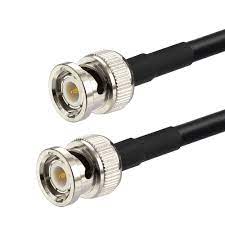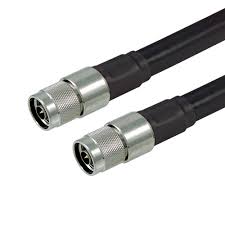The F connector, shown in the picture above, is the most common for cable, satellite, and HDTV uses. It uses a hexagonal, screw-on outer shell that can be tightened with a 7/16" or 11mm wrench. It can also be configured as a push-on connector, and we'll discuss the benefits of that a little later in the article.

The BNC connector, shown above, is most commonly used for commercial video applications. Unlike the screw-on F connector, it uses a "push and turns" motion that makes it easy to connect and disconnect firmly without a wrench. However, its construction allows signal "leakage" in the higher frequencies. This isn't an issue for HD video or computer data transmitted locally on relatively low frequencies but it makes the BNC connector a worse choice for cable or satellite.

This is the N connector. It's not seen as common but it's a really beefy connector for long runs. It uses a screw-on outer connector to minimize signal leakage as well as a center shield to further isolate the cable. This connector has been in wide use for a long time and it's more common in older installations done before compression connectors became common.
What to look for in a connector

This image, courtesy of Wikipedia, shows one of the worst possible F connectors installs.
Let's take a look at this picture and see what's wrong with it. First, start with the yellow color of the connector. Gold-colored connectors became popular in the 1980s when high-end audio fans used real gold-plated ones to make better connections. Unfortunately, this opened the door for other people to slap gold paint on their connectors because it's hard to tell the difference.
This connector is either painted or it's solid brass. Either way, that's not so great. Painting a connector actually reduces the quality of the signal, and brass connectors are great when you buy them but oxidize quickly, leading to signal loss.
The knurled edge of this connector means it's probably a screw-on type. Screw-on connectors are a cheap way for DIY'ers to build cables without tools. Unfortunately, they often end up loose and the screw-on action can tear the inner braid or destroy a thin foil shield. Just stay away from screw-on connectors.
Look at the dielectric. A good cable should have the dielectric flush with the inner edge of the connector, while this dielectric is sunk down.
As if this poor cable hadn't suffered enough, look at the center conductor! It should be straight and free of kinks, with a sharp, 90 degree cut at the edge. This conductor isn't going to make good contact, because it's all kinked.